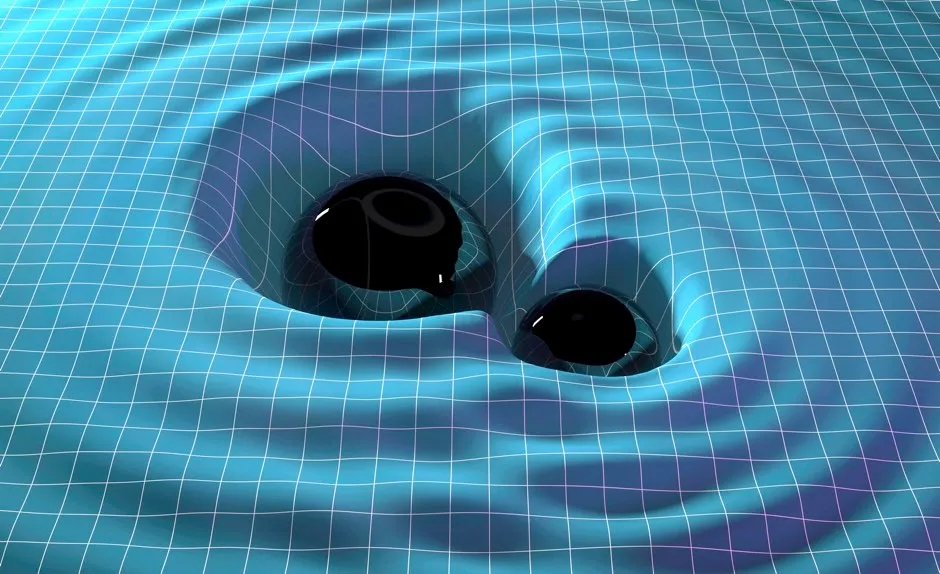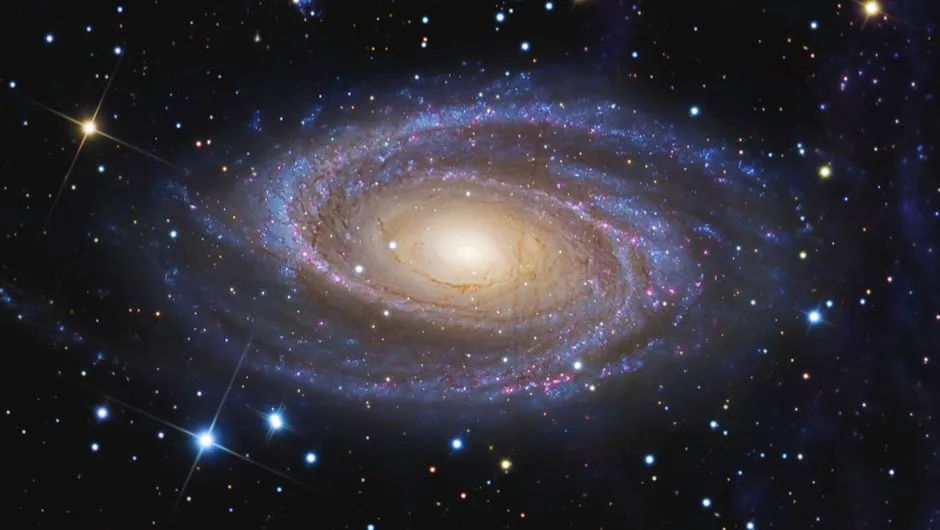Scientific riddles don’t come much more baffling than this: entire galaxies seem to be in the grip of something that affects their behaviour, but no one knows what this ‘something’ is. If it’s a form of matter, then it must be the most abundant matter in the cosmos, yet all attempts to get a sample of it have failed. Not even the Large Hadron Collider has seen a glimpse of it. It remains as enigmatic as its name: dark matter.
Now, one theorist has provoked controversy with a devastatingly simple explanation for why dark matter still hasn’t been found: it doesn’t exist.
But that’s not the only reason Prof Erik Verlinde of the University of Amsterdam is attracting so much attention. After all, others have previously suggested dark matter may be some kind of illusion.
Read more:
- The incredible story of how we discovered black holes
- Dark energy is hiding in our Universe - here's how we'll find it
What sets Verlinde apart is his explanation for the source of the illusion. He believes it’s the result of nothing less than a fundamental misconception about the most familiar force in the Universe: gravity.
It’s a claim that brings Verlinde up against the work of some of the greatest minds in science – including Albert Einstein, whose celebrated theory of gravity is one of the cornerstones of modern physics. Known as General Relativity, it has led to a host of triumphs, including the detection in 2015 of gravitational waves – ripples in the fabric of space-time caused by the collision of two black holes.
The truth about gravity
Verlinde has spent years piecing together clues from theory and observation to create a whole new vision of the force we call gravity. Now his ideas are being put to the test, with intriguing results. And at the centre of them all is the mystery of dark matter.
Verlinde has been hailed as the intellectual successor to Einstein in the media, yet he sees his goal in more down to earth terms. “I’m just trying to explain where gravity comes from,” he says.
That might seem a bizarre statement, coming a century after Einstein showed that gravity is the result of matter warping space and time around it. Yet according to Verlinde, this overlooks the fact that General Relativity remains just a description of the force we call gravity. It leaves unanswered the key question of exactly how matter affects space and time.

To carry out his research, Verlinde has had to grapple with some of the deepest problems in science, including the quest for the so-called Theory of Everything – a theory that unites gravity with quantum mechanics that has been considered the holy grail of physics for decades.
Theorists have long known that General Relativity cannot be the last word about gravity. That’s because it fails to incorporate the other cornerstone of modern physics, quantum theory. As well as describing the subatomic world with astonishing precision, quantum theory has been able to account for all the fundamental forces of nature apart from one: gravity. Since the 1950s, theorists have tried to marry the two views of nature to produce one overarching theory.
The problem, says Verlinde, is that they are based on such radically different views of reality. For example, General Relativity presumes that it’s possible to pin down precisely where particles are and how they’re moving, while quantum theory shows that’s impossible. “So taking gravity into account gives us a bit of a problem”, explains Verlinde.
For years, he worked on superstring theory, which many believe to be the most promising way of overcoming these problems. Yet despite decades of effort and a host of mind-boggling ideas, there is still no hard evidence that it works.
This has led Verlinde down a different path in search for the truth about gravity. The origins of this truth lie in a series of surprising connections between gravity and an apparently unrelated part of science: thermodynamics, the physics of heat.
Read more:
- The nine most mysterious objects in the Universe
- From apples to gravitational waves: a brief history of gravity
In the early 1970s, theorists studying black holes – notorious for the intensity of their gravity – discovered they must also be packed with something called entropy. Widely used to understand the behaviour of hot objects, entropy reflects the number of ways of rearranging the constituents of objects without changing their appearance. Calculations showed that black holes contain the highest possible entropy that can be crammed into a given volume of space.
But they also revealed something else. Common sense suggests that as it depends on the constituents of objects, the entropy of a black hole should depend on its volume. Yet theorists found it depends only on the hole’s surface area. Stranger still, the calculations suggest the black hole’s surface is made up of a vast patchwork of so-called Planck areas. Named after the eponymous German pioneer of quantum theory, Planck areas are far smaller even than a subatomic particle, and appear to be the building blocks of space-time itself.
Pondering these mind-bending connections between the physics of heat and space-time, Verlinde began to wonder if they were hints of a radical new way of thinking about gravity. Heat was once thought to be a fundamental property of matter that exists in and of itself, like electric charge, for example, but it’s now known to ultimately be the result of collisions between the millions of atoms and molecules that make up a gas, liquid or solid. The faster the atoms and molecules that make up a material move, the more energy they have and the hotter the material appears. Thus heat is actually an ‘emergent’ property.
So could the supposedly fundamental force of gravity also be emergent, its real origins being linked to entropy and those incredibly tiny Planck areas of space-time?
Newton and Einstein
In 2010, Verlinde created a stir among theorists when he published a paper showing how his theory could be used to accurately derive both Newton’s and Einstein’s laws of gravitation. “The similarities with other known emergent phenomena such as thermodynamics have been mostly regarded as just suggestive analogies,” declared Verlinde. “It is time we not only notice the analogy, and talk about the similarity, but finally do away with gravity as a fundamental force.”
While intriguing, many theorists remained unconvinced the finding was anything more than a quirk of physics. Verlinde needed to come up with something that didn’t merely reproduce existing theories, but predicted something new – and testable. He now believes he’s found it with the enigma of dark matter.

While hints of its existence emerged over 80 years ago in studies of clusters of galaxies, it was a discovery of a curious effect inside galaxies that first convinced astronomers to take dark matter seriously.
According to Newton’s law of gravity, stars further from the centre of a galaxy should orbit more slowly than those closer in. But during the 1970s, studies of stars within spiral galaxies showed that beyond a certain distance from the centre, this effect simply vanished. The most obvious explanation was that the stars were being affected by the gravity of an invisible cloud of matter surrounding the galaxies. It soon became clear that whatever this stuff was, it couldn’t be made from the standard building blocks of matter. That sparked a global effort to detect a viable alternative, which continues to this day – with no success.
This has led to growing suspicions that the most obvious explanation is simply wrong. In 1983, physicist Prof Mordehai Milgrom of the Weizmann Institute in Israel, pointed out a curious fact about the galactic evidence for dark matter: it can also be explained if Newton’s law fails to accurately explain the motions of stars in the outer reaches of galaxies feeling an acceleration due to gravity at a rate less than a certain critical value: around 100-billionth that generated by the Earth.
Testing, testing
While intriguing, what Milgrom called Modified Newtonian Dynamics (MOND) simply replaced one mystery with another: where did this ‘critical acceleration’ come from? That’s what Verlinde decided to find out using his ideas of emergent gravity. “I quickly found a back-of-the-envelope calculation that might explain it, but I had to work for a number of years to make this more precise,” he says. And now believes he has succeeded.
The key lies in the effect of the entire Universe on the vital ingredient needed for the existence of gravity: entropy. According to both Newton and Einstein’s theories, the entropy of objects like black holes increases with their area. But Verlinde has shown things change on the scale of the whole Universe, because of dark energy. First identified in the 1990s, dark energy is a kind of anti-gravitational force that is propelling the expansion of the Universe. Its origins remain mysterious, but calculations by Verlinde show that dark energy leads to entropy increasing with volume, not just area. That changes the behaviour of gravity at cosmic scales – and, says Verlinde, the result is an acceleration effect creating the illusion that dark matter exists.
“In an expanding Universe, the gravitational laws have to be adjusted at the acceleration scale indicated by MOND,” he says. Unlike MOND, however, he has been able to calculate the effect using basic physics.
Verlinde’s theory does more than explain why dark matter has never been found. Astronomers have long been puzzled by a ‘law’ linking the brightness of spiral galaxies to their spin rate. Known as the Tully-Fisher relation, it makes no sense using conventional theories of gravity, but Verlinde has shown that it’s a natural consequence of the link between gravity and entropy.

Further evidence backing Verlinde’s theory comes from recent studies of the light from distant galaxies. According to Einstein, the gravity field of galaxies can bend the path of light rays. This is known as the ‘gravitational lens’ effect. An international team of astronomers has found that this effect is consistent with the predictions of Verlinde’s theory, without the need for dark matter.
Now the search is on for evidence that Verlinde’s theory does not just explain MOND, but outperforms it. And here some problems have emerged. Astronomer Dr Frederico Lelli and his colleagues at the European Southern Observatory have been studying the orbits of stars in galaxies, and they’re not behaving as expected.
“Verlinde’s theory predicts a stronger gravitational pull than MOND in the inner regions,” explains Lelli. But this effect doesn’t seem to exist: “This seems to be a serious issue,” he says.
The biggest problem facing Verlinde, however, is explaining a cosmic ‘coincidence’. Why does the amount of dark matter needed to explain galaxy rotation curves match the amount needed to explain observations of the early Universe? “The observational evidence for dark matter from a variety of methods is all amazingly consistent,” says astrophysicist Prof Neta Bahcall of Princeton University.
The simplest explanation is that dark matter really does exist, but just hasn’t been found yet. But Verlinde points out that his work on the nature of gravity is far from complete. “To explain these effects one has to develop the theory to the point where one can describe the cosmological evolution of the Universe,” he says. “I am currently working on these ideas, but it will take some time.”
Given the huge pay-off if he’s right, many scientists are willing to cut Verlinde some slack. “We’re in a period when it is necessary to explore many new ideas,” says astronomer Prof Stacy McGaugh of Case Western Reserve University, Ohio. “And it takes a long time for such things to settle out.”
- This article was first published in October 2017
Follow Science Focus onTwitter,Facebook, Instagramand Flipboard